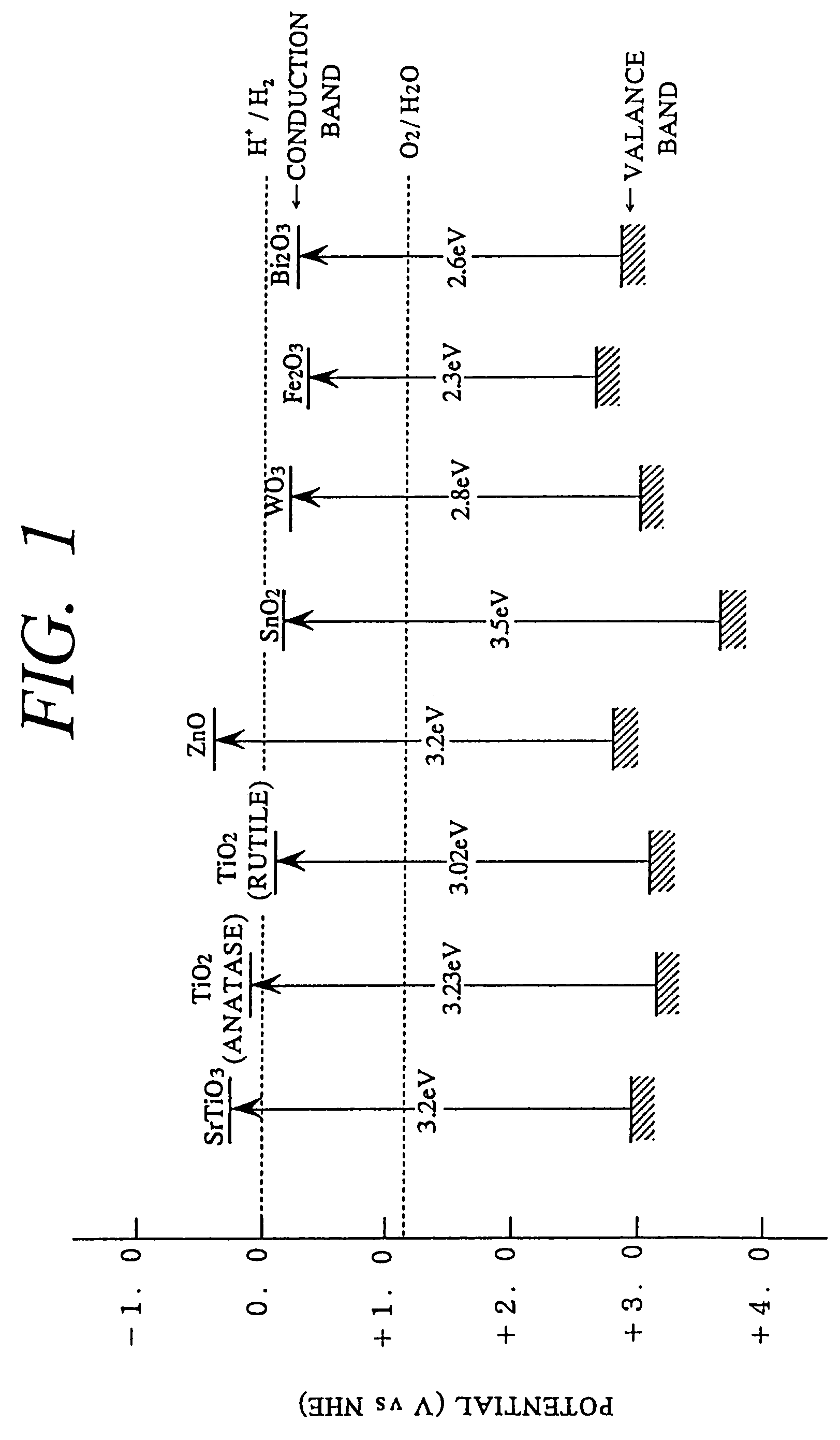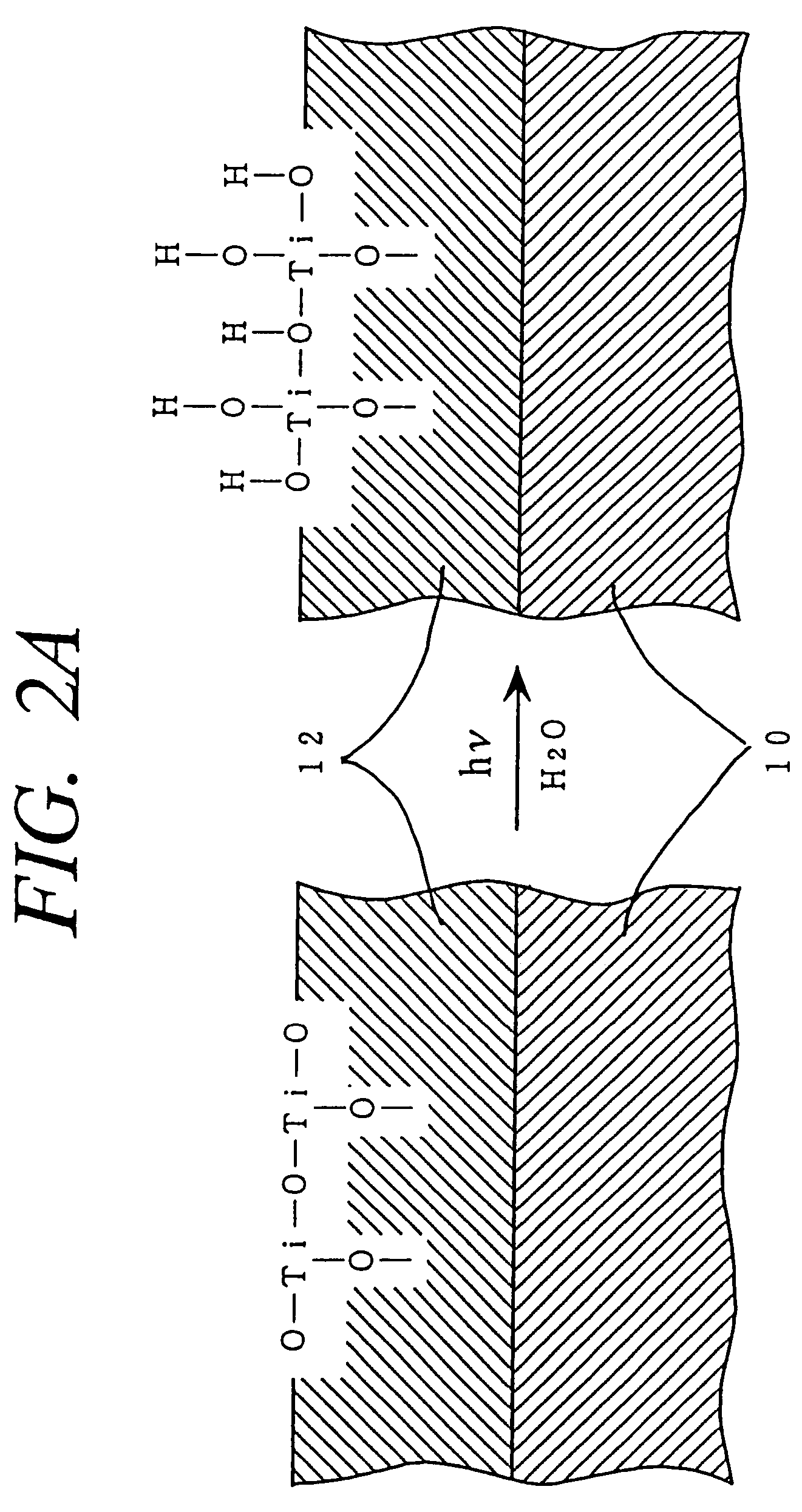Method for photocatalytically rendering a surface of a substrate superhydrophilic, a substrate with superhydrophilic photocatalytic surface, and method of making thereof
a technology of superhydrophilic and photocatalytic surface, which is applied in the direction of cleaning using liquids, other chemical processes, instruments, etc., can solve the problems of steam affecting mirrors and eyeglass lenses, loss of visibility, and image viewed through transparent objects such as sheet glass may become distorted
- Summary
- Abstract
- Description
- Claims
- Application Information
AI Technical Summary
Benefits of technology
Problems solved by technology
Method used
Image
Examples
example 1
Antifogging Mirror—Antifogging Photocatalytic Coating with Interleaved Silica Layer
[0128]6 parts by weight of tetraethoxysilane Si(OC2H5)4 (Wako JunYaku, Osaka), 6 parts by weight of pure water, and 2 parts by weight of 36% hydrochloric acid as a hydrolysis inhibitor were added to 86 parts by weight of ethanol as a solvent and the mixture was stirred to obtain a silica coating solution. The solution was allowed to cool for about 1 hour since the solution evolved heat upon mixing. The solution was then applied on the surface of a soda-lime glass plate of 10 cm square in size by the flow coating method and was dried at a temperature of 80° C. As drying proceeds, tetraethoxysilane was hydrolyzed to first form silanol Si(OH)4 which then underwent dehydration polymerization to form a thin film of amorphous silica on the surface of the glass plate.
[0129]Then a titania coating solution was prepared by adding 0.1 parts by weight of 36% hydrochloric acid as a hydrolysis inhibitor to a mixtur...
example 2
Antifogging Mirror—Photocatalytic Coating Comprising Silica-Blended Titania
[0140]A thin film of amorphous silica was formed on the surface of a mirror (made by Nihon Flat Glass, MFL3) in a manner similar to Example 1.
[0141]Then a coating solution was prepared by admixing 0.69 g of tetraethoxysilane (Wako JunYaku), 1.07 g of a sol of the anatase form of titania (Nissan Chemical Ind., TA-15, mean particle size of 0.01 μm), 29.88 g of ethanol, and 0.36 g of pure water. The coating solution was applied on the surface of the mirror by spray coating process. The mirror was held at a temperature of about 150° C. for about 20 minutes to subject tetraethoxysilane to hydrolysis and dehydration polymerization to thereby form on the mirror surface a coating wherein particles of the anatase form of titania were bound by a binder of amorphous silica. The ratio by weight of titania to silica was 1.
[0142]After the mirror was kept in the dark for several days, a UV light was irradiated by the BLB fl...
example 3
Antifogging Eyeglass Lens
[0144]First, a thin film of amorphous silica was formed in a manner similar to Example 1 on both sides of an eyeglass lens commercially available on the market.
[0145]Then, the coating solution similar to that of Example 2 was spray coated on both sides of the lens and the lens was held at a temperature of about 150° C. for about 20 minutes to subject tetraethoxysilane to hydrolysis and dehydration polymerization to thereby form on each side of the lens a coating wherein particles of the anatase form of titania were bound by a binder of amorphous silica.
[0146]After the lens was kept in the dark for several days, it was irradiated with UV light from a BLB fluorescent lamp for about one hour at a UV intensity of 0.5 mW / cm2. When the contact angle with water at the surface of the lens was measured by the same contact angle meter as used in Example 1, the reading of the contact angle meter was 0°. This lens was mounted to the right-hand side of a pair of eyeglass...
PUM
| Property | Measurement | Unit |
|---|---|---|
| contact angle | aaaaa | aaaaa |
| contact angle | aaaaa | aaaaa |
| contact angle | aaaaa | aaaaa |
Abstract
Description
Claims
Application Information
 Login to View More
Login to View More - R&D
- Intellectual Property
- Life Sciences
- Materials
- Tech Scout
- Unparalleled Data Quality
- Higher Quality Content
- 60% Fewer Hallucinations
Browse by: Latest US Patents, China's latest patents, Technical Efficacy Thesaurus, Application Domain, Technology Topic, Popular Technical Reports.
© 2025 PatSnap. All rights reserved.Legal|Privacy policy|Modern Slavery Act Transparency Statement|Sitemap|About US| Contact US: help@patsnap.com



